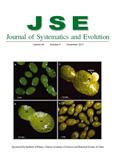Table of Contents
-

Volume 49 Issue 6
Cover illustration: Clonal and sexual reproduction of Wolffia plants, the smallest angiosperm. A, Plants of Wolffia globosa (Roxb.) Hartog in clonal reproduction. B, Close-up view of W. globosa vegetative fronds showing mother frond (MF) and daughter fronds (DF). C, Close-up view of W. globosa fronds showing maturation of minute protogynous flowers. D, Several flowering fronds under natural condition. Photographed by Jun-Xia YUAN and Qing HUANG. See YUAN et al., pp. 509–517 in this issue.
Editors-in-Chief
Song Ge
Jun Wen
Song Ge
Jun Wen
Impact Factor
3.7
JCR 2022 IF ranking: 60/238 (Plant Sciences, top 25%, Q2 quartile)
Journal Abbreviation: J Syst Evol
CN: 11-5779/Q
Frequency: Bi-monthly
Journal Abbreviation: J Syst Evol
| ISSN: | 1674-4918 (Print) 1759-6831 (Online) |
Frequency: Bi-monthly

Scan to view the journal on your mobile
device
device

Scan to follow us on WeChat







